
In the latest rendition of UST Live, we were joined by thought leaders from across the U.S. with expertise in nonprofit advocacy. Guest moderator, Chai Jindasurat of Nonprofit New York, lead the conversation as the group discussed how advocacy efforts have changed and shared what their nonprofit organizations are doing to ensure they’re being heard at the local, state, and federal levels.
You’ll also hear where they see cross-sector advocacy aligning in the next 12-18 months and what you can do to capture the attention of legislators to effect change—plus much more.
Watch now to discover:
Upcoming UST Live Webinars: This webinar series was designed to equip nonprofits with the strategies and resources they need to survive (and thrive) in a constantly evolving environment. Be on the lookout for future UST Live sessions—scheduled for May, August, and November.

This article was written by Mitch Stein, Founder & CEO at Pond and shared with explicit permission.
The nonprofit workforce has been through a lot in the last few years—they’ve faced job insecurity and financial shortcomings as well as mental and emotional strain—leaving many burnt out and pursuing new jobs. In order to achieve stability, nonprofits need to be innovative with development opportunities that can help combat preventable terminations.
In a recent article by Pond, “How to Build a Professional Development Plan for the New Nonprofit Landscape,” Mitch Stein shares strategies for building a professional development plan that ensures employees are prepared and able to perform critical tasks in times of uncertainty while also being supported in their career trajectory. You’ll learn how to identify skills gaps, curate professional development resources, encourage cross-training, and align your development program around your nonprofit’s core values.
Remember, in the end, most nonprofit employees want to feel fulfilled and competent in what they do—they want to contribute as well as make a difference. These strategies can help you sustain your organization’s workforce and remain competitive in today’s ever-evolving employee marketplace.

The grantmaking process is often exclusive and expensive, making it accessible to those select nonprofits with the right expertise and networks, which can be costly for organizations and funders to seek and distribute funding. Applying for grants is a tedious and expensive process, with a good percentage of applications taking upwards to a week or more just to write. To help those communities who’ve been commonly excluded to thrive, organizations with access to capital need to start adopting more equitable grantmaking practices—making funding more accessible to everyone. Grantmakers have a responsibility to create equitable processes, making sure that communities of color and other marginalized populations are not adversely impacted by giving practices.
When looking at grantmaking, diversity includes casting a wide net to attract diverse applicants. Inclusion might mean your reviewers are diverse, mirroring the community the organization serves. Equity might include revamping the application process making it more accessible.
In following these four tips, nonprofit organizations will be more equipped to have the right processes in place to evaluate equitable grantmaking:
1) Create a More Diverse Pool of Applicants: The first step toward equitable grantmaking is to encourage a diverse applicant pool. If nonprofits serving marginalized communities don’t know about your funding, they won’t be able to apply. Examine your pipeline to determine if you’re casting a wide net outside of your familiar go-to organizations. Look into expanding your networks—we all have a tendency to build relationships with those like ourselves. Attend diverse community meetings, events, or town halls to promote your fund.
2) Keep the Entire Application Process Simple: Grant applications can feel complicated to newer applicants. Use clear, simple language when creating instructions and applications. The general rule is to write at an eighth-grade reading level. (Word offers this functionality–you can use google to find out how to use it). When it comes to equitable grantmaking, ADA-friendly applications are a must. For example, screen reader capability and keyboard accessibility create an equitable website experience. Without these, applicants with disabilities may have difficulty applying.
3) Lower Chances of Bias in Review Process: Implicit bias is an unconscious association made about social groups. For example, many automatically assume business executives are male and secretaries are female. While it is ingrained in us from a young age, implicit bias can hinder best intentions for equitable grantmaking. By creating an unbiased review process, you’ll strengthen the entirety of the grant review process. Some examples include, offer implicit bias training to your reviewers and examine reasons why applicants were rejected.
4) Review Reporting Metrics: Metrics are vital to any funder’s success—including equitable giving outcomes. Be sure to create equity metrics early in the process. You’ll want to track data points such as the number of diverse applicants and awardees.
To reduce funding barriers, make sure to take a closer look at your processes from beginning to end. Take a look at each step and try to pin-point when diverse populations are no longer in the forefront. Be open to outside perspectives who could provide unique solutions—grantees and reviewers could offer ideas around inclusivity and/or equity.
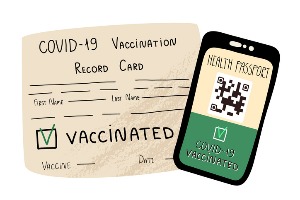
Question: Can we share employee vaccination status with managers so they can enforce any policies based on that information, such as masking and social distancing?
Answer: Yes. Obviously, managers will need this information if they are expected to enforce vaccination-dependent policies, and employers should train them on how they should be enforcing the policies and how and when to escalate issues to HR or a higher level of management. However, you should not share this information any more widely than necessary. Vaccination status is medical information that must be kept confidential.
While anonymized information is okay to share widely—e.g., “80% of our employees are vaccinated!”—each employee’s vaccination status should be treated as confidential, even if the fact that they are wearing a mask to work seems to reveal their status publicly.
Q&A provided by Mineral, powering the UST HR Workplace. Have HR questions? Sign your nonprofit up for a FREE 60-day trial here. As a UST member, simply log into your Mineralportal to access live HR certified consultants, 300+ on-demand training courses, an extensive compliance library, and more.

Today’s increasingly virtual landscape—along with the workforce’s evolving strategic priorities—has not only changed how we work, but it’s also impacted the way we interact with one another. Employee engagement practices are an essential part of any organization—they can save the company money, improve productivity, increase morale, and decrease turnover. To maintain positive morale and strengthen company culture, nonprofit leaders must prioritize employee engagement and brand reputation strategies.
For just $29 you can discover helpful tactics for building a strong nonprofit brand while fostering an engaged workforce. During this on-demand webinar, you’ll learn:
Register today and you’ll also receive essential handouts for nonprofit leaders—including an employee engagement checklist, a comprehensive onboarding plan as well as creative ideas for celebrating your team and more—FREE with your registration.

Members are a vital key to success when sustaining and growing your association and retaining those members ensures a long-term survival of your nonprofit organization. While recruiting and enrolling new members is important for growth, making a conscience effort to retain members is equally as important. Making your current members feel important and special, reminds them of why they joined your association in the first place. Some tried and true retention methods include creating specialized resources, and educational content—the more you publish industry reports, educational webinars, or offer member discounts, the happier your members will be.
The best course of action to take when retaining members include, focusing on their needs, remind them how much value they bring to your association and engaging them on a regular basis. We’ve put together a list of 5 best practices for improving member retention at your nonprofit organization:
1) Create an Onboarding Plan: First-time members are a specific group within your membership profile that need to be approached with specific strategies. Look for ways to keep new members engaged—monthly check-ins, education materials about new products, keep them informed about upcoming events like webinars or virtual conferences—give them opportunities to learn more about the work your organization is doing in the nonprofit sector.
2) Offering Member Only Benefits: Members are interested and/or passionate about your cause, and they want to feel like they’re making a difference. Communicate with them often with weekly or monthly newsletters as well as through social media. Provide perks such as exclusive, member-only offers from your partners as well as networking opportunities. If possible, provide educational opportunities such as webinars, workshops, and relevant eBooks at member-only prices.
3) Create a Community for Your Members: Encourage a thriving, engaged community of like-minded individuals. Such as, organizing/hosting more networking events, mentorship programs, and creating an online member directory—all methods that can help to increase member retention.
4) Remind Members of the Value You Offer: In your end-of-year communications to members, remind them how their membership with your organization has benefited their association over the past year and how much value their membership brings to your organization.
5) Ask Members to Complete an Exit Survey: While it’s not ideal, it is the reality that there will be members who will choose to cancel their membership. This is a great opportunity to capture unique insight into why a member is leaving by asking them to fill out an exit survey. The data acquired can bring light to pitfalls or areas of your organization to be reviewed and improved upon.
Member retention isn’t just a one-time activity. It is something that’s kept in mind throughout the whole member lifecycle—it’s a strategy that requires just as much attention as recruiting new members. To keep members around long-term, you should be focusing on building better relationships with your members from day one.

Question: HR Compliance: What It Is and Why It’s So Complicated
Answer: Running a business comes with no shortage of perks. You get the freedom to be your own boss, invest in an idea, steer its trajectory, and create wealth. It has its challenges, too. Competition may be fierce. Demand for what you offer may be low. Costs may not be sustainable. But even if everything else is going your way, there’s one challenge that’s ever-present. We’re talking, of course, about HR compliance.
The Definition of HR Compliance
HR compliance is the work of ensuring that your employment practices conform to federal, state, and local laws. This work requires learning which laws apply to your organization and understanding what they require you to do. That’s easier said than done.
HR compliance is truly an art. It requires knowledge, skill, and cooperation. You have to be able to decipher legalese, know where to go to ask the right questions, and create policies and procedures that minimize business risk. You have to ensure that everyone from the executive team to newly minted managers know what they can and cannot do. You have to conduct investigations and enforce your rules consistently. And all this is just the bare minimum—necessary, but not enough to create a truly successful culture.
The work of compliance is never entirely done. Not only do new legal requirements appear on the regular, but, as you’ll read below, compliance obligations are often unclear. While some compliance obligations are definitive, others are unresolved, and a good number require you to make a judgment call. Let’s look at each of these in turn.
Why HR Compliance Can’t Always Be Assured
Some employment laws take the form of “Do this” or “Don’t do that.” The requirements may be simple, like minimum wage, or complex, like FMLA, but either way there’s usually no real question about what you need to do or not do. Compliance with these laws is pretty straightforward. Don’t pay less than the minimum wage. Provide leave to eligible employees for the reasons that qualify, continue their health benefits (if applicable), and return them to their position when their leave ends. As long as you’re clear on the details, you’re not likely to lose sleep wondering if you’re compliant.
Sometimes, however, those details are unsettled. Lawmakers don’t always specify everything a law requires before it passes or takes effect. Even when laws seem clear, trying to put them into practice often raises a lot of questions. And the legislature isn’t the only source of law: regulatory agencies demand their say, and courts get involved, too. To complicate matters, these branches of government don’t always agree with each other, and what they say today may not be what they say tomorrow. Keeping up with the latest official guidance takes time and persistence. It can feel like a marathon, when what you want is a quick sprint to the answer. You have other demands on your time, after all.
Finally, a lot of employment laws have standards you have to follow, but they don’t tell you how. Neither the IRS nor the DOL, for example, tells you whether your workers are employees or independent contractors—unless there’s an audit or complaint. Instead, these agencies publish tests with general criteria that you use to make case-by-case determinations.
The Americans with Disabilities Act (ADA) works this way, too. The ADA requires employers to provide reasonable accommodations to employees with disabilities, with a few exceptions. One of the exceptions is that the accommodation doesn’t create an undue hardship on the employer’s business. The basic definition of an undue hardship is an action that creates a significant difficulty or expense. Although the law provides factors to consider in making this determination, the onus is on you to decide whether an expense or difficulty from an accommodation is significant. And, ultimately, your conclusion could be challenged in court.
Why HR Compliance Looks Like This
If HR compliance seems overly-complicated, that’s because it is. Our current legal landscape is the result of three competing philosophies about how the workplace should be governed, who should govern it, and whose rights in the workplace should be prioritized in the law.
Owner Control
According to the first view, business owners should have control over their workplaces for one simple reason. They own the business. It’s their property, and as owners they should have the legal right to govern it. Employees have no right to control aspects of the workplace because the workplace isn’t theirs. They don’t own it. It’s not their property. If they don’t like the terms and conditions of their employment, they can and should go elsewhere.
While an owner might employ managers or an executive team to make decisions about who to hire and fire, what to pay, how to assign work, and other such matters, the owner remains in charge. Advocates of this view include the economist Milton Friedman. In 1970, he famously argued that corporate executives should bow to the desires of the owners. The will of the owners reigns supreme.
Worker Control
According to the second view, workers should have a say in the decisions that get made simply because those decisions affect them and their livelihoods. In this line of thinking, the governance of the workplace should adhere to the principles of democracy. However, proponents for this view differ on how democracy in the workplace should be practiced.
In the 1930s, Senator Robert F. Wagner introduced the National Labor Relations Act. He wanted to guarantee the “freedom of action of the worker” and ensure that workers were “free in the economic as well as the political field.” Today, talk of democratizing the workplace usually refers to bolstering unions. But there are other proposals to note. Some champions of workplace democracy, like Senator Elizabeth Warren, have pushed for employee representation on corporate boards. Others favor cooperative models in which the division between employers and employees doesn’t exist.
Full-fledged workplace democracy is still a fringe view, though. The very definition of an employee remains a worker who does not have the right to control what the work is, how it’s done, or how it’s compensated. Employees may be given authority to make decisions. They may have influence over their superiors. But they are not legally in charge.
Societal Control
Advocates of the third view argue that the government has an interest in exercising some measure of control over the work and the workplace. In the employer-employee relationship, employers typically have significantly more power than employees—especially an employee acting as an individual. Frances Perkins, who served as Secretary of Labor and was a key architect of the New Deal, believed that government “should aim to give all the people under its jurisdiction the best possible life.” She saw a role for legislatures in countering long hours, low wages, and other conditions unfavorable to employees.
How These Philosophies Have Played Out
In the United States, HR compliance is the result of these three competing and arguably incompatible philosophies. Government action with respect to employment has tried to empower workers and afford them certain rights, protections, and freedoms in the workplace, all while preserving the employer’s control over their business.
We can see this balancing act in the differences among state laws. Some states prioritize the right of owners to control their workforces and are loath to restrict that right through legislation. Other states act out of what they see as a duty to secure the rights of workers. Imposing obligations on employers doesn’t bother them.
We also see this balancing act in the way that employment laws tend to set parameters rather than dictate exactly what employers must do. You can pay employees whatever you want, so long as you pay at least the minimum, offer an overtime premium when applicable, and meet equal pay requirements. You can theoretically terminate employment for any reason or no reason at all (though we don’t recommend it); but you can’t fire someone for an illegal reason. Even laws that require a new practice, such as paid leave, allow flexibility provided you meet minimum conditions.
Takeaways
First, when you’re assessing your compliance obligations, understand that not all compliance obligations are clearly delineated or settled law. Unsettling as that may be, it’s how our system has been set up. In those cases, you’ll have to weigh your options and the risks involved, and then make a decision. Sometimes you may need legal advice in addition to HR guidance. Remember, however, that despite all the many employment laws on the books and in the imaginations of legislators, the system is designed to keep employers in charge. You can’t eliminate all risk, but by understanding the nuances and open questions, you can significantly minimize it.
Second, document your actions and decisions. It only takes an employee filing a complaint for enforcement agencies to get involved, but you are better protected if you can quickly and clearly explain to them the reason for your actions.
Third, evaluate whether your policies, procedures, and practices are satisfactory to employees. No employment law gets written in a vacuum, and no law is truly inevitable. Lawmakers passed the Fair Labor Standards Act because workers and the general public felt that labor standards were unfair. Today we wouldn’t have people pushing for predictive scheduling laws if they felt that work schedules were already sufficiently predictable. Harassment prevention training wouldn’t be mandatory (where it is) if sexual harassment weren’t widespread.
Fourth, lead by example. Make good employee relations a key part of your brand and competitive advantage. Employees have higher expectations today than they used to. Meet those expectations and motivate other employers to do the same, and you may find that the compliance landscape of the future is less winding and boggy than it could have been.
Finally, spend some time each day learning about your compliance obligations. Use resources that break down federal and state employment laws in a way that laypeople can understand. Keep up to speed on the latest compliance obligations and contingencies you should consider. HR compliance is an art. The first step to mastering it is learning what it entails and how it works.
You can also download the Telecommuting Checklist as a tool for when an employee is transitioning to a remote schedule. Q&A provided by Mineral, powering the UST HR Workplace. Have HR questions? Sign your nonprofit up for a FREE 60-day trial here. As a UST member, simply log into your Mineral portal to access live HR certified consultants, 300+ on-demand training courses, an extensive compliance library, and more.

Question: How do I make a telecommuting policy?
Answer: Although some employers will be comfortable sending everyone home with their laptop and saying, go forth and be productive, most will want to be a little more specific. A good telecommuting policy will generally address productivity standards, hours of work, how and when employees should be in contact with their manager or subordinates, and office expenses.
For instance, your policy might require that employees are available by phone and or a messaging app during their regular in-office hours, that they meet all deadlines and maintain client contacts per usual, and that they check in with their manager at the close of each workday to report what they have accomplished. Be sure to let employees know whom to contact if they run into technical difficulties at home.
You’ll also want to specify how expenses related to working from home will be dealt with. If you don’t expect there to be any additional expenses involved, communicate this. You don’t want employees thinking this is their chance to purchase a standing desk and fancy ergonomic chair on your dime. That said, you should consider whether employees will incur reasonable and necessary expenses while working from home. Some states mandate reimbursement for these kinds of expenses, but it’s a good practice to cover such costs even if it’s not required by law.
You can also download the Telecommuting Checklist as a tool for when an employee is transitioning to a remote schedule. Q&A provided by Mineral, powering the UST HR Workplace. Have HR questions? Sign your nonprofit up for a FREE 60-day trial here. As a UST member, simply log into your Mineral portal to access live HR certified consultants, 300+ on-demand training courses, an extensive compliance library, and more.

Newly promoted managers face challenging circumstances in the early stages of transitioning roles. By understanding the different ways leaders approach business problems, you can learn to speak to each accordingly—integrating the collective knowledge to solve matters of strategic organizational importance.
This session takes a deep dive into each of the seven conceptual shifts necessary to move from managing to leading. You’ll learn practical tips for creating strategies to transition from tactical manager to strategic leader. In this webinar, we’ll discuss:
• Understanding mindsets at a manager versus leader level
• How to recognize behaviors that prevent leadership progression
• Tactics you can use to change behaviors that limit leadership progression
Discover the seven most challenging mindsets of new managers, and how you can create development plans to move to better leadership behaviors.
You can also check out our GoToStage Webinar Channel—your one-stop-shop for viewing UST’s most popular and FREE on-demand webinars—to keep up-to-date on important legal changes and nonprofit trends that may impact your organization.

Nonprofit managers are relied upon to not only lead productive teams, hold employees accountable, and manage processes but are also expected to engage and motivate employees with limited funding. They must be innovative, resourceful, and strategic. To help nonprofit leaders maintain high-performing teams—while also strengthening their leadership skills—we created the 2021 Nonprofit Leadership Toolkit.
This free toolkit includes a performance appraisal checklist, manager-employee check-in form, tips for leading a hybrid workforce, and more:
Want access to more HR-specific articles, templates and checklists? Sign up for a FREE 60-Day Trial of UST HR Workplace today! You’ll also gain access to live HR certified consultants, 300+ on-demand training courses and an extensive compliance library.

After an extremely challenging year (or two) of workforce disruptions, nonprofit employers are finding their footing again. And, with the holidays upon us and more organizations supporting flexible routines—working remote, adopting a hybrid model, or still meeting in-person—many are looking for creative ways to celebrate the holidays with their devoted staff. It’s these events and get-togethers that bind employees together and makes them feel valued while also improving overall morale.
Opportunities to recognize employee achievements and strengthen team connections should never be overlooked but especially not during this time of year. Whether you realize it or not, your employees miss their colleagues and the fun activities they use to do together such as holiday celebrations—even if they prefer working from home. A sense of community among your remote or hybrid team is crucial for building a positive employee experience and maintaining your nonprofit brand.
All of the activities below are designed to accommodate teams regardless of their work location or time zone. You can even run some of these activities over the course of a few days (or weeks) ensuring all participants have time to respond. And, with a little research you can find a plethora of helpful templates, checklists, and directions online to assist with coordinating a fun-filled event.
Get creative and take the time to celebrate your team this year by spreading a little extra holiday cheer! By planning something fun and engaging for your team, you can renew loyalty, get employees excited about the new year ahead, and nurture company culture.

Whether you’re aspiring to be an executive leader, get promoted into a director’s position, or even launch your own nonprofit—rarely there are clearly defined paths to career development when working in the nonprofit sector. While this lack of structure can be challenging, it offers an unexpected opportunity to pave or create your own career path. Without the typical career ladder to climb, the opportunity to take on new responsibilities could be presented to you in a more timely fashion. At any age, with drive, desire and expertise being essential characteristics, you can become a nonprofit leader who wants to make a difference.
In order to create the right professional development plan, here are nine methods to follow, to consider, and use as a guide when furthering ones’ professional career as a nonprofit leader:
1) Conduct thorough interviews: Find those who hold a position that you might aspire to want one day. Take the opportunity to ask questions about how they got to where they are, what their day-to-day tasks look like, how they contribute to the organization, and what the position requires of them.
2) Seek out volunteer opportunities: When it comes to learning, especially within the nonprofit sector, there’s no substitute for hands-on experience. Volunteering can offer exposure to the operational facets of the organization by taking on new responsibilities, such as, join the fundraising or strategic planning committee or volunteer to help with the organization’s next event.
3) Ongoing education: If you’re looking for an advantage when pursuing leadership opportunities, consider looking into continuing education (i.e.: an advanced degree, or a specific leadership training program). Having this additional training under your belt will set you apart being well versed in business management principles and the ability to juggle competing priorities.
4) Learn about your organization: Take the time to develop a well-rounded view of everything that is involved in the role of running a nonprofit. This experience will be valuable to you as you progress into a leadership position.
5) Apply constructive feedback: As you take on new challenges and work outside your comfort zone, it’s more than likely you’ll make mistakes along the way. Take the time to learn from these and plan how you will do better in the future.
6) Network amongst your peers: Find people who are at a similar point in their own careers and develop genuine relationships with them. Be sure that you add real value to the relationship and that way, your peers will come to value you—opening doors for you in the future.
7) Relocate to another organization: With a strong foundation of skills in place and a desire to take on more responsibility, you might find that your current organization doesn’t have any openings for you to move up to. Take this opportunity to look for other employment and if you find a great position within your network, don’t hesitate to pursue it.
8) Join a nonprofit board: Being part of a board will give you high-level insights about the inner workings of nonprofits. Develop relationships with others who serve on nonprofit boards and seek out an organization doing work/serving a community that you’re passionate about.
9) Find day-to-day challenges: Leaders face challenges daily, so it is crucial to avoid becoming complacent. Striving to challenge yourself on a daily basis will not only push you to find solutions, it will help you build your resume.
When applying these methods, you will develop the skills and knowledge necessary to successfully lead an organization. If you envision yourself in a leadership role, you’ll have the ability to lay the foundation by excelling in the position you currently hold. These methods will help you cultivate leadership skills, emphasize teamwork and inclusive decision-making.

One of the main reasons employees leave their jobs is because they don’t feel appreciated—causing many to question their work and often looking for a job elsewhere. Not surprisingly, but now more than ever before employees expect their workplace to deliver a productive, engaging, and enjoyable experience so to keep high performing employees on the payroll, leaders must consider recognition efforts a top priority. Celebrating achievements at work is also an important part of the productivity cycle and can transform the organization by keeping everyone aligned to the mission and values that contribute to its long-term success.
Impactful recognition has little to do with money and doesn’t need to be extravagant to be effective—it should however be genuine and come from a place of appreciation. It’s important that leaders celebrate wins big and small as both are equally valuable and impactful. Often missed opportunities to celebrate an employee include successful completion of large or new projects, teamwork, work anniversaries, and ongoing behavior that positively impacts fellow co-workers. When a manager takes the time to regularly demonstrate gratitude and appreciation for an employee’s accomplishments—both professional and personal—it can motive, engage, and reinforce positive behaviors and outcomes.
Remind your employees that you value their contributions and celebrate their successes. Check out UST’s “5 Ways to Celebrate Your Team” for some creative ways you can start recognizing your team.
It’s up to leaders to find opportunities to celebrate their employees while also encouraging employees to celebrate each other. By creating a culture of recognition, you can improve morale and ensure your most valuable assets remain motivated to stay.

Question: What are some typical examples of employee discipline? Are there any you recommend?
Answer: Discipline should reflect the severity of the behavior, attempt to correct it, and be applied consistently. You’ll want to consider how you addressed certain behaviors in the past and the precedent you want to set for the future. For instance, if you jump straight to a final warning when a certain employee is an hour late to work, but let another employee come in late regularly without so much as a written warning, you’re setting yourself up for trouble.
We generally recommend progressive discipline. This means you start small and work your way up to termination. Progressive discipline often includes these steps:
At each step, make your expectations clear, notify the employee of the consequences if they fail to improve (that they’ll be one step closer to termination), and document what actions you took. The warnings you give to the employee should stick to the facts, i.e., what infraction was observed, when it occurred, and what policy or policies were violated. Opinions about the infraction should be left out, as these are easily disputed. For example, “Yesterday, you arrived 20 minutes late in violation of our attendance policy” simply states the facts, whereas “You’re always tardy and can’t be trusted to arrive on time” is likely to get pushback.
Q&A provided by Mineral, powering the UST HR Workplace for nonprofit HR teams. Have HR questions? Sign your nonprofit up for a free 60-day trial here. As a UST member, simply log into your Mineral portal to access live HR certified consultants, 300+ on-demand training courses, an extensive compliance library, and more.

A strong leadership team is vital to the success of any nonprofit organization—without it you risk reduced productivity, delayed decisions, and low morale. Rooted in the ability of a nonprofit to maintain sustainability, having a leadership succession plan in place is vital to organizational success.
Don’t miss your chance to download a free copy of UST’s latest Employer Guide, 3 Vital Steps for Developing a Durable Nonprofit Leadership Team, to discover strategies that can help identify (and develop) tomorrow’s leaders with training opportunities designed to strengthen your brand and build resilient teams. In this eBook, you’ll discover:
The consequences of insufficient leadership can be devastating to an organization. Safeguard your nonprofit and its mission by reinventing your organizational leadership strategy—minimizing the threat (and high cost) of turnover.

Flexible work arrangements have been around for decades but now that we’re beginning to see the new era of work take shape it’s more important than ever to support and manage remote teams in a way that allows them to work effectively from home—ensuring sustainability of day-to-day operations. Managing employees without daily face-to-face interaction has its own unique set of challenges but when leaders focus their skills on the right set of best practices employees—and organizations—can excel.
Being proficient at managing remote employees requires strong communication skills, reachability, positive reinforcement, flexibility, and empathy. Productivity is no longer based on “desk time” and visible activity, managers must now gauge success based on outcomes and revise how they lead their people while finding new ways to keep them engaged.
Implement these best practice tips to improve morale, productivity, and engagement.
There are many ways to develop better relationships with a remote team that include transparent communication, open doors, and clear expectations to name a few. Micromanaging employees has never been a favorable practice and can cause undue stress for employees—leaving them to feel like they’re not trusted to do their work. While these best practice tips require time, attention, and consistency, they can help to develop healthy habits that allow your team to maintain productivity and achieve goals.

As employers continue to strategize for the future—paving the way for flexible work models and creative retention tactics—many are seeing permanent change take place. UST surveyed more than 400 nonprofit leaders from across the U.S. to uncover the latest sector trends caused by the pandemic and created the 2021 Workforce Trends Infographic.
Download your free copy today to get a sneak peak at what your nonprofit peers had to share about their top workforce issues, COVID’s impact on staffing levels and more.
For only $99, you can also download a copy of the complete 2021 Nonprofit Sector Report to uncover valuable insight on how nonprofits continue to navigate the ongoing challenges that have risen throughout the pandemic.

Question: Generally, our employees are “always on,” meaning they check work emails and communicate with co-workers/supervisors via smartphone during all hours. However, some of our employees are beginning to feel overwhelmed. Any suggestions?
Answer: Although employers may see the “always on” employee as highly productive, the constant state of being readily available can leave employees feeling overwhelmed and exhausted. To combat this struggle, employers may:
Note: The application of any new or existing workplace policy must be applied consistently and without discrimination throughout the workforce.
Q&A provided by Mineral, powering the UST HR Workplace for nonprofit HR teams. Have HR questions? Sign your nonprofit up for a free 60-day trial here. As a UST member, simply log into your Mineral portal to access live HR certified consultants, 300+ on-demand training courses, an extensive compliance library, and more.
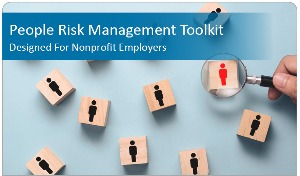
Hiring new employees can be time-consuming, costly, and stressful. Pre-employment assessments can be useful in determining whether or not a potential new hire is a good fit candidate—with the right skills and mind set for your organization. A proven, scientific way to screen candidates and mitigate the risks of hiring mistakes, incorporating pre-employment testing can be the most effective way to gain a more thorough picture of a candidate’s strengths, skills and personality.
As we know, people-related risks within an nonprofit organization can range from bad hires and misconduct to harassment and lack of diversity in the workplace. To help nonprofit employers strengthen their employee risk management practices—and mitigate the risks that can ultimately affect your bottom line—we created the 2021 People Risk Management Toolkit.
This toolkit includes a performance improvement plan, a risk audit questionnaire, risk management best practice tips and more:
Take the time to thoroughly vet your candidates before hiring. The cost of pre-employment screening is minimal compared to the cost of hiring someone who doesn’t stay. Not to mention, that an employee who isn’t a good fit—for the job or your workforce—can also impact the entire team and overall morale.
If you’re looking for access to more HR-specific articles, templates and checklists? Sign up for a FREE 60-Day Trial of UST HR Workplace today! You’ll also gain access to live HR certified consultants, 300+ on-demand training courses and an extensive compliance library.

Nonprofit employers nationwide are living through a fundamental transformation in the way they work and the pace at which employee priorities are changing. In the latest rendition of UST Live, we were joined by leaders from across the U.S with expertise in nonprofit management to discuss innovative strategies for creating a forward-looking workplace culture that is flexible, inclusive, and resilient.
Watch now to discover:
Upcoming UST Live Webinars: UST Live was designed to equip nonprofit leaders with strategies that can help sustain their workforce and their mission-driven initiatives. In our final session of the year—scheduled for early December—we’ll discuss nonprofit leadership and succession planning.
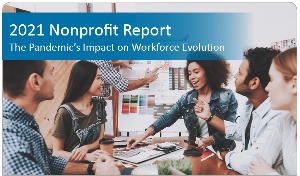
Are you curious to discover how nonprofits have pivoted strategies in response to COVID-19 and how this pandemic is causing permanent change across the sector? With over 400 survey respondents—representing a wide variety of nonprofits from across the U.S.—this report unveils the pandemic’s impact on workforce evolution and illustrates how the sector withstood the hardships caused by the crisis.
Download the report to learn:
This report will provide valuable insight on how nonprofit organizations are navigating the ongoing challenges that have arisen throughout the pandemic. For only $99, download your copy of the 2021 sector report today!

Question: Can we require remote employees to have childcare?
Answer: We do not recommend having a policy that stipulates childcare is necessary. For one thing, in practice, it often isn’t necessary. Lots of employees are able to do their jobs just fine while supervising children in the home. Imposing this requirement (and a huge financial burden) won’t solve any problems, but it may encourage remote employees to start looking for a new job. Even in cases where supervising children does negatively affect job performance, requiring childcare as a solution could be seen as crossing a line into your employees’ personal lives.
Instead of requiring childcare, we recommend setting clear expectations for attendance, availability, performance, and productivity. You can then discipline employees who don’t meet these expectations without giving the impression that you’re micromanaging their personal lives.
It’s also worth keeping in mind that employee expectations around remote work have changed. People choose remote work with the idea that they’ll have more flexibility during the day to attend to their personal responsibilities. If that flexibility isn’t an option, it’s important to make that clear so employees know what to expect.
Q&A provided by Mineral, powering the UST HR Workplace for nonprofit HR teams. Have HR questions? Sign your nonprofit up for a free 60-day trial here. As a UST member, simply log into yourMineralportal to access live HR certified consultants, 300+ on-demand training courses, an extensive compliance library, and more.

Risk management is defined as a discipline for dealing with the possibility that some future event will cause harm and nonprofit risk comes in an endless number of forms—data security, fundraising fraud, regulatory compliance, employee relations, volunteer staff, and theft just to name a few. Given the myriad of ways that nonprofits are changing the world and the impossible task of being able to predict every potential mission-disrupting event, every organization stands to benefit from risk reducing tactics. This is where risk management comes in—an essential necessity that helps nonprofits understand the threats they face and how to prioritize strategies that create sustainability in the future.
Developing a risk management process is essential to every nonprofit but many remain unprotected simply because they don’t have the funds or resources to implement such a strategy. There are however other ways to protect your organization without breaking the bank that just require more time and dedication to create and streamline. So, if you don’t have a risk management strategy in place already, now is the time to start.
Follow these four steps to create a risk management strategy:
A single liability incident can easily cost tens of thousands of dollars, not to mention the harm it can do to your reputation. In short, by taking the time to identify risks, prioritize issues, respond to the problems, assess the situation, and improve your strategy, nonprofit employers can better protect their assets and avoid future risks.
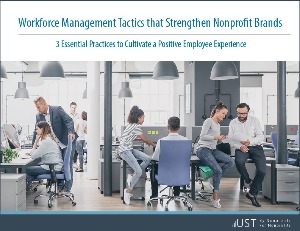
One of the biggest challenges nonprofits are faced with is the “great resignation” sparked by the pandemic—where employees are burnt out and pursuing new jobs that better align with their evolving priorities. In order to stay competitive in today’s job market, nonprofit leaders must reinvent their recruitment tactics, work-life balance initiatives and employee engagement strategies.
Don’t miss your chance to download a free copy of UST’s latest eBook, Workforce Management Tactics that Strengthen Nonprofit Brands, to discover 3 key strategies that can help your nonprofit create (and sustain) a resilient workforce.
In this eBook, you’ll discover:
This eBook will help you uncover new strategies that will encourage your current (and future) workforce to carry out your mission for years to come.

Question: Do OSHA’s regulations and standards apply to the home office? Are there any other federal laws employers need to consider when employees work from home?
Answer: The Department of Labor’s Occupational Safety and Health Administration (OSHA) does not have any regulations regarding telework in home offices. The agency issued a directive in February 2000 stating that the agency will not conduct inspections of employees’ home offices, will not hold employers liable for employees’ home offices, and does not expect employers to inspect the home offices of their employees.
If OSHA receives a complaint about a home office, the complainant will be advised of OSHA’s policy. If an employee makes a specific request, OSHA may informally let employers know of complaints about home office conditions but will not follow-up with the employer or employee.
Employers who are required to keep records of work-related injuries and illnesses will continue to be responsible for keeping such records for injuries and illnesses occurring in a home office.
The Fair Labor Standards Act (FLSA) and its implementing regulations do not prevent employers from implementing telework or other flexible work arrangements allowing employees to work from home. Employers would still be required to maintain an accurate record of hours worked for all employees, including those participating in telework or other flexible work arrangements; and to pay no less than the minimum wage for all hours worked and to pay at least one and one-half times the employee’s regular rate of pay for all hours worked over 40 in a workweek to nonexempt employees.
Employers are encouraged to work with their employees to establish hours of work for employees who telework and a mechanism for recording each teleworking employee’s hours of work. Nonexempt employees must receive the required minimum wage and overtime pay free and clear. This means that when a covered employee is required to provide the tools and equipment (e.g., computer, Internet connection, facsimile machine, etc.) needed for telework, the cost of providing the tools and equipment may not reduce the employee’s pay below that required by the FLSA.
Under the Americans with Disabilities Act (ADA), telework could be a reasonable accommodation the employer would need to provide to a qualified individual with a disability, barring any undue hardship. However, an employer may instead offer alternative accommodations as long as they would be effective.
Q&A provided by Mineral, powering the UST HR Workplace for nonprofit HR teams. Have HR questions? Sign your nonprofit up for a free 60-day trial here.

Turnover is a natural part of any nonprofit organization’s life cycle, and employee offboarding should be handled with the same degree of importance as onboarding a new employee. An offboarding plan offers an opportunity for communication and manage change, to help preserve and improve your employer brand and to generate good faith with the departing employee. There can be many moving pieces involved with a termed employee and clear offboarding procedures help manage the expectations of all parties involved.
When done correctly, the employee offboarding process can offer key management insights and reveal hidden internal issues. From a management point of view, the focus is to address issues at an organization level. Whereas, employees are faced with small issues that aren’t always noticed by managers or the executive team. Not giving attention and time to these small and recurring issues can lead to larger issues which could then impact the productivity of the organization.
Here are some best practices when creating an efficient and smooth employee offboarding process:
1) Learn why the employee is leaving: Maybe the employee wasn’t a long-term fit for your company culture, perhaps they came across a career-changing opportunity, or they weren’t a fit to handle growth gracefully. Regardless of the reason, organizations need to first understand the reason why an employee wants to leave and have a clear plan in place to handle each type of exit. Having the appropriate policies and procedures in place to handle any and all offboarding reasons are key for orchestrating a smooth departure.
2) Conduct a smooth offboarding: A crucial aspect of a good employee offboarding process is to treat employees warmly, regardless of the reason behind their departure. Creating a positive farewell will encourage employees to speak to others positively about their experience which in turn, increases the organization’s brand value. Taking the opportunity to engage departed employees will help with talent acquisition and managing the reputation of the organization’s brand.
3) Ask for feedback: When an employee leaves, it can be a valuable opportunity to collect insightful turnover data. During the exit interview, the employee can offer honest feedback about the organization since they are no longer reliant on this job for financial means. When an employee expresses their desire to leave, sending them an exit interview survey can help organizations uncover areas of opportunities that need to be addressed to improve employee engagement and productivity.
4) Avoid decreases in productivity: When an employee departs, day-to-day activities overseen by this employee will be interrupted or possibly put on pause—resulting in a decrease in productivity. Cross training with current employees can prevent a dip in productivity, such as, transferring process knowledge, document procedures and responsibilities, and login credentials for business tools.
Depending on the reason for the employee’s departure, exit interviews are an opportunity to collect important insights to improve your current offboarding strategy. The complexities involved in offboarding make saying “goodbye” to employees a challenging task—which is why consistency is the key to a successful exit interview. With the right tools in place, organizations have the ability to standardize the complexities involved in employee offboarding and help you part ways in the most efficient way.

Question: As we begin to return to work, if an employee is out of the office due to sickness, can we ask them about their symptoms?
Answer:Yes, but there’s a right way to do it and a wrong way to do it. In non-pandemic circumstances, employers shouldn’t ask about an employee’s symptoms, as that could be construed as a disability-related inquiry. Under the circumstances, however — and in line with an employer’s responsibility to provide a safe workplace — it is recommended that employers ask specifically about the symptoms of COVID-19.
Here is a suggested communication: “Thank you for staying home while sick. In the interest of keeping all employees as safe as possible, we’d like to know if you are having any of the symptoms of COVID-19. Are you experiencing a fever, cough, shortness of breath, chills, muscle pain, headache, sore throat, or a new loss of taste or smell?”
Remember that medical information must be kept confidential as required by the Americans with Disabilities Act (ADA). If the employee does reveal that they have symptoms of COVID-19, or has a confirmed case, the CDC recommends informing the employee’s co-workers of their possible exposure to COVID-19 in the workplace (but not naming the employee who has or might have it) and directing them to self-monitor for symptoms. Employers should also follow CDC guidance for cleaning and disinfecting.
Q&A provided by ThinkHR, powering the UST HR Workplace for nonprofit HR teams. Have HR questions? Sign your nonprofit up for a free 60-day trial here.
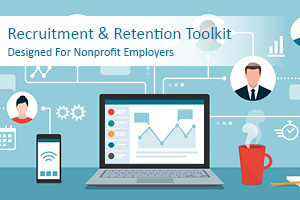
Recruiting and retaining top performers is crucial to the success of any nonprofit and when done right, reaps the best reward—employees that support and strengthen your mission-driven work. To help nonprofit employers strengthen their recruiting and retention practices—while focusing on the employee’s entire journey with the organization—we created the 2021 Recruitment and Retention Toolkit .
This free toolkit includes a recruiting checklist, workplace flexibility fundamentals, interview best practice tips, and more:
Would you like access to more HR-specific articles, templates and checklists? Sign up for a FREE 60-Day Trial of UST HR Workplace today! You’ll also gain access to live, certified HR consultants, 300+ on-demand training courses, an extensive compliance library, and more.

UST just released the latest edition of our Quarterly Nonprofit Digest. This quick reference guide highlights key findings from last quarter’s most popular content—which focused on innovative nonprofit sustainability strategies to help employers thrive in these ever evolving times.
If you’re a nonprofit leader, download your free copy of the Q2 quarterly digest to discover essential strategies for:
You’ll also gain access to helpful checklists, people risk management templates and best practice tips to help you plan (and execute) a successful virtual event.
To get more nonprofit-exclusive content, webinar invitations and sector insights delivered straight to your inbox, sign up for UST’s eNewsletter today.
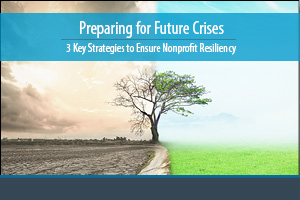
UST recently published an eBook that discusses how the global pandemic challenged nonprofits in ways that were unprecedented at that time and how taking the time to develop better defenses against subsequent crises—building greater resilience against natural, economic and health threats—nonprofits can move toward a better prepared future.
This insightful eBook uncovers strategies that can help nonprofits implement a game plan that will help ensure organizational sustainability in the wake of the next disaster. Available now for download, UST’s eBook will help you protect your employees, continuity of services and the communities you serve when future challenges arise.
In this eBook, you’ll also discover:
Don’t miss your opportunity to download your complimentary copy of “Preparing for Future Crises: Strategies to Ensure Nonprofit Resiliency” to discover how to protect your nonprofit and its workforce from future crises.

UST maintains a secure site. This means that information we obtain from you in the process of enrolling is protected and cannot be viewed by others. Information about your agency is provided to our various service providers once you enroll in UST for the purpose of providing you with the best possible service. Your information will never be sold or rented to other entities that are not affiliated with UST. Agencies that are actively enrolled in UST are listed for review by other agencies, UST’s sponsors and potential participants, but no information specific to your agency can be reviewed by anyone not affiliated with UST and not otherwise engaged in providing services to you except as required by law or valid legal process.
Your use of this site and the provision of basic information constitute your consent for UST to use the information supplied.
UST may collect generic information about overall website traffic, and use other analytical information and tools to help us improve our website and provide the best possible information and service. As you browse UST’s website, cookies may also be placed on your computer so that we can better understand what information our visitors are most interested in, and to help direct you to other relevant information. These cookies do not collect personal information such as your name, email, postal address or phone number. To opt out of some of these cookies, click here. If you are a Twitter user, and prefer not to have Twitter ad content tailored to you, learn more here.
Further, our website may contain links to other sites. Anytime you connect to another website, their respective privacy policy will apply and UST is not responsible for the privacy practices of others.
This Privacy Policy and the Terms of Use for our site is subject to change.
UST maintains a secure site. This means that information we obtain from you in the process of enrolling is protected and cannot be viewed by others. Information about your agency is provided to our various service providers once you enroll in UST for the purpose of providing you with the best possible service. Your information will never be sold or rented to other entities that are not affiliated with UST. Agencies that are actively enrolled in UST are listed for review by other agencies, UST’s sponsors and potential participants, but no information specific to your agency can be reviewed by anyone not affiliated with UST and not otherwise engaged in providing services to you except as required by law or valid legal process.
Your use of this site and the provision of basic information constitute your consent for UST to use the information supplied.
UST may collect generic information about overall website traffic, and use other analytical information and tools to help us improve our website and provide the best possible information and service. As you browse UST’s website, cookies may also be placed on your computer so that we can better understand what information our visitors are most interested in, and to help direct you to other relevant information. These cookies do not collect personal information such as your name, email, postal address or phone number. To opt out of some of these cookies, click here. If you are a Twitter user, and prefer not to have Twitter ad content tailored to you, learn more here.
Further, our website may contain links to other sites. Anytime you connect to another website, their respective privacy policy will apply and UST is not responsible for the privacy practices of others.
This Privacy Policy and the Terms of Use for our site is subject to change.